| Dr. Laurel A. Neme is the author of ANIMAL INVESTIGATORS: How the World’s First Wildlife Forensics Lab is Solving Crimes and Saving Endangered Species. Neme also hosts The WildLife with Laurel Neme, a program that explores the mysteries of the animal world through interviews with scientists and other wildlife investigators. |
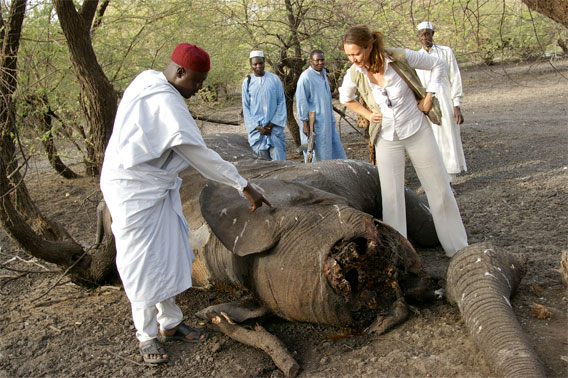 Stephanie Vergniault and villager looking at elephant carcass. Courtesy of SOS Elephants
Stephanie Vergniault and villager looking at elephant carcass. Courtesy of SOS Elephants
Poachers killed at least 30 elephants in southwestern Chad during the early hours of Tuesday, July 24. During the night, Stephanie Vergniault, president of the organization SOS Elephants, described on her Facebook page how a group of armed horsemen chased a herd of elephants with “war weapons near the SOS Elephants camp in the Chari Baguirmi area. After daybreak, the SOS Elephants team counted 28 carcasses, most with missing tusks. The exact number of carcasses with missing tusks is unclear because the team was afraid to stay and investigate further due to the presence of the poachers hiding on the other side of the Chari River.
The elephant massacre occurred as 350 participants from all over the world attend the 62nd meeting of the Convention on International Trade in Endangered Species of Wild Fauna and Flora (CITES) Standing Committee in Geneva, Switzerland, where the illegal killing of elephants and ivory smuggling are at the top of the agenda. On Tuesday, the Standing Committee discussed the close correspondence between rising trends in elephant poaching and large-scale ivory seizures and recommendations to improve the situation. It also considered a new report, titled “Decision-Making Mechanisms and Necessary Conditions for a Future Trade in African Elephant Ivory,” that explores the future legalization of international ivory trade and the potential establishment of a Central Ivory Selling Organization (similar to the DeBeers diamond cartel).
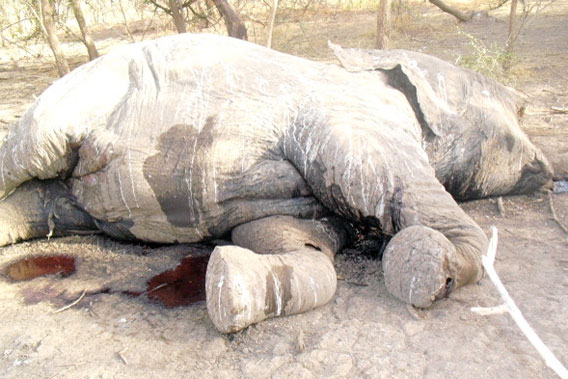 Elephant carcass. Courtesy of SOS Elephants
Elephant carcass. Courtesy of SOS Elephants
Local communities and the SOS Elephants team living permanently at the camp, including SOS Elephants’ Secretary General Raphael Djimadibaye, who heard the attack informed the Paramount Chief. The Chief contacted Vergniault, who spoke with local authorities, and in turn immediately sent soldiers to track the poachers.
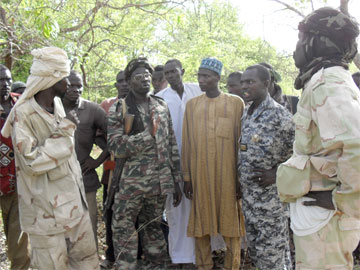 Paramount Chief Oumar Mamadi protecting the elephants with SOS Elephants of Chad team members 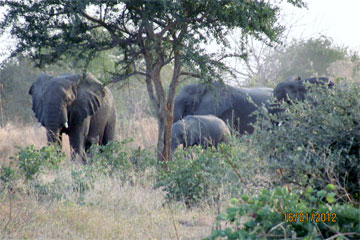 Elephants near camp 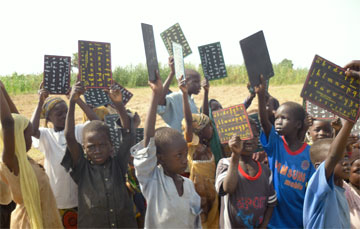 SOS Elephants is working with the local community and paying the school fees of 270 children. All photos are courtesy of SOS Elephants (Stephanie Vergniault) |
The day following the attack, the SOS Elephants team found a baby elephant in the area, whose mother had likely been killed in the incident. The SOS Elephants team rescued the orphaned elephant, carrying the three-week-old male, now nicknamed “Toto”, to camp and giving him milk formula.
Vergniault suspects the massacre was carried out by Chadians who are part of a local “ivory mafia” that is “backed by some officials” and makes “dirty deals with the Chinese labor” at the oil refinery. The refinery is a joint venture between the China National Petroleum Corporation (CNPC), who owns 60 percent, and the Chad government (the state firm Société des Hydrocarbures du Tchad, SHT). The plant, which is designed to process crude oil from wells in the Southern Bongor region through a 311 kilometer pipeline, opened in June 2011 with initial production of 20,000 barrels-per-day (bpd). That production is expected to increase to 60,000 bpd, with output intended for local consumption in Chad and the sub-region.
According to the International Fund for Animal Welfare, Chad’s elephant population has plummeted from 4,000 individuals in 2006 to about 2,500 in 2010, the year of the most recent census. Given on-going high levels of poaching that number has likely declined still further. In Zakouma National Park, elephant numbers dropped from 3,000 elephants in 2006 to 940 in 2008 and 450 today. Vergniault estimates that about 1,500 elephants remain in Chad, with 450 in Zakouma, 300 in the (unprotected) Chari Baguirmi-Mayo Lemie area, and 700 spread around the country.
If poaching continues at this rate, Vergniault says, “not a single elephant will be alive in Chad in three years time.” She is calling for the establishment of permanent anti-poaching units and also for stronger penalties for those caught poaching.
SOS Elephants is the only non-government organization in Chad dedicated to preserving elephants and their habitats. It works through a combination of research, education, conservation and counter-poaching actions. The organization has developed a network of 100 to 200 local people who inform about poaching activities, including providing positions of poachers or elephants. It recently opened SOS Elephants in Congo.
Related articles
Poacher known as ‘Morgan’ behind devastating massacre at Okapi Wildlife Reserve
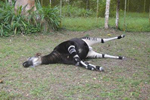
(07/05/2012) Officials have pointed to an infamous elephant poacher known as ‘Morgan’ as the head of the murderous attack at the Okapi Wildlife Reserve station in the Democratic Republic of the Congo (DRC) late last month. The attack by Morgan and his crew left seven people dead, including two wildlife rangers. The poachers also shot dead 13 captive okapis at the headquarters, which were considered ambassadors for the imperiled forest. One okapi remains alive, but injured and conservationists are not optimistic about its survival. UNESCO and the the NGO Fauna and Flora international have issued an emergency appeal to raise $120,000 dollars within two weeks for the victim’s families as well as for rapidly rebuilding the station.
Elephant numbers halved in Central Africa in 5 years
(06/08/2012) Elephant numbers in areas surveyed by the Wildlife Conservation Society (WCS) in Central Africa halved between 2006 and 2011, hinting at the carnage wrought by the surging commercial ivory trade and demonstrating a need to boost protection efforts, said the Bronx Zoo-based conservation group.
Banning ivory sales to China could save elephants
-EIA.150.jpg)
(03/24/2012) Although the international ivory trade has been banned since 1989, last year was the worst ever for elephant poaching, and this year has begun little better as reports come out of Cameroon of hundreds of elephants slaughtered in a single park. What went wrong? According to a new briefing by the Environmental Investigation Agency (IEA), approved legal auctions of ivory by the Convention on International Trade in Endangered Species (CITES) to Japan and, especially, China has fueled, rather than abated as promised, the illegal trade along with mass deaths of elephants across Africa.
Military called in to stop Cameroon elephant slaughter – but may be too late
(03/05/2012) Cameroon’s military has been called in to Bouba Ndjida National Park to take on foreign poachers that have slaughtered hundreds of elephants for their ivory, according to the World Wide Fund for Nature (WWF). Reports vary, but between 200-480 elephants have been killed in recent weeks in the park by what is widely assumed to be poachers from Sudan.
Elephant death-toll rises to almost 500 in one park in Cameroon (warning: graphic photo)
(02/29/2012) Wildlife officials have found 458 dead elephants in Cameroon’s embattled Bouba Ndjida National Park, reports the AFP. However officials fear the actual number is even higher around 480. Over the last six weeks a well-organized group of poachers has run free in the park, slaughtering elephants for their ivory tusks which will make their way to markets in Asia.
Elephant massacre in Cameroon (warning: graphic photo)
(02/17/2012) More than 200 elephants have been slaughtered for their tusks in less than a month in Cameroon, reports the International Fund for Animal Welfare (IFAW). The group blames Sudanese poachers for cross-border raids from Chad into Bouba Ndjida National Park in northern Cameroon.
A nation of tragedies: the unseen elephant wars of Chad
(05/12/2010) Stephanie Vergniault, head of SOS Elephants in Chad, says she has seen more beheaded corpses of elephants in her life than living animals. In the central African nation, against the backdrop of a vast human tragedy—poverty, hunger, violence, and hundreds of thousands of refugees—elephants are quietly vanishing at an astounding rate. One-by-one they fall to well-organized, well-funded, and heavily-armed poaching militias. Soon Stephanie Vergniault believes there may be no elephants left. A lawyer, screenwriter, and conservationist, Vergniault is a true Renaissance-woman. She first came to Chad to work with the government on electoral assistance, but in 2009 after seeing the dire situation of the nation’s elephants she created SOS Elephants, an organization determined to save these animals from local extinction.
Chad’s elephant population falls by two-thirds in two years
(12/11/2008) Civil strife of Chad — a consequence of the calamity in Darfur — is taking a toll on the country’s elephant population, reports the Wildlife Conservation Society (WCS) which has launched an emergency appeal for funds to support conservation efforts in the country.
